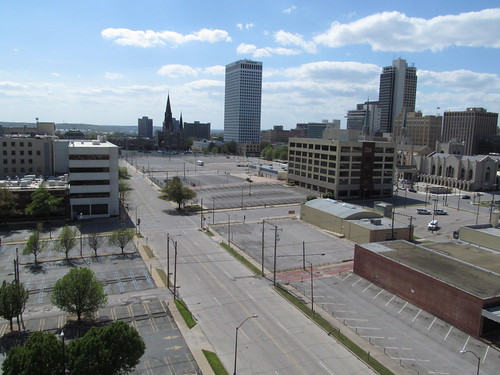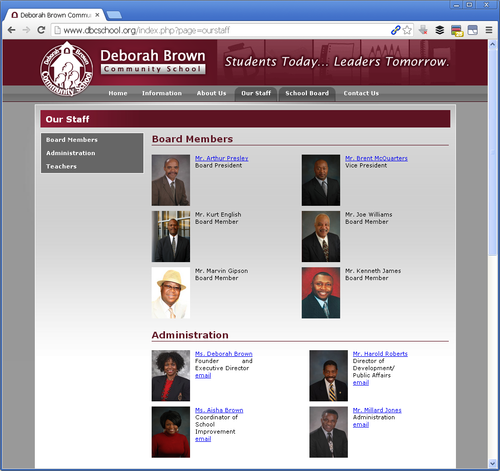September 2013 Archives
As one of a series of ten stories on the use and abuse of executive power by the Obama Administration, the Washington Examiner this week revisited the illegal subordination of federally guaranteed loans made to Solyndra, a modification to the loan agreement that benefited Argonaut Private Equity, owned by Obama campaign bundler George Kaiser.
The law under which the loan guarantees were granted, the Energy Policy Act of 2005, requires that taxpayers are first in line to be repaid in the event of bankruptcy. According to news reports, Kaiser demanded and was granted a restructuring of the financing that put his company ahead of the taxpayers in the repayment line. Obama's Department of Energy invented a novel reinterpretation of the law to allow them to nullify the law's protection of the taxpayers' interests, over the objections of government lawyers.
DOE also asked its outside counsel, Morrison & Foerster LLP, for its opinion, which described the offer as "prohibited."The Office of Management and Budget also concluded that the DOE's Solyndra loan modification was illegal. On Dec. 14, 2010, OMB analyst Kelly Colyar, formerly the credit policy director at DOE, informed OMB Deputy Associate Director Richard Mertens of a problem "regarding the proposed structure's compliance with the statutory requirement that the DOE guaranteed debt not be subordinate to other financing." A Jan. 4, 2011, OMB staff memo said the same thing....
In direct opposition to the plain meaning of the statute and OMB guidelines on government contracting, DOE lawyers invented a new legal theory that the ban on subordination applied only at loan origination and was not a "continuing obligation."
In other words, since the Solyndra restructuring was a loan modification, DOE could do whatever it wanted.
Upon hearing this novel interpretation, OMB Energy Branch Chief Kevin Carroll said the DOE's reasoning meant "that basically DOE could modify to allow subordination on any loan, at any time, for any reason."
According to the Examiner's analysis, the taxpayers got soaked by Solyndra:
Kaiser has done well despite Solyndra's woes. Taxpayers can expect no more than $24 million returned from the original $527 million investment. Kaiser's investment firm got $975 million in tax breaks that could cut its future federal income tax bills by a third.
Former Councilor and mayoral candidate Bill Christiansen announced today that, having met this week with Tulsa Mayor Dewey Bartlett Jr to discuss his concerns, he has decided not to endorse Bartlett Jr.
According to Christansen, Bartlett told him he doesn't have a platform for his second term in office and "will not talk about one out of fear that people will hold him accountable" for delivering on his promises.
Christiansen also took issue with Bartlett Jr's frequently-repeated campaign claim that Kathy Taylor drove Tulsa to the brink of bankruptcy. There was never any danger of that, not because Taylor was a good steward of the city's budget (she wasn't and neither has Bartlett Jr been), but because of state laws and constitutional provisions that require a balanced budget.
In early 2010, Fire Chief Allan LaCroix said, "The layoffs have to occur by February 15th, or the city's in the position it may have to file bankruptcy. That's how serious this situation is," but he quickly walked the statement back, saying, "It's just a term." At the time, Dewey Bartlett Jr disavowed the idea that Tulsa was going bankrupt:
Mayor Dewey Bartlett says the reality is the city is "not in the throes of bankruptcy."The News On 6 caught up with the mayor just before he flew to Dallas to participate a business recruiting trip.
"If we don't take action today, tomorrow, soon, in several months, six months, 12 months from now, we could be, serious financial problems," said Dewey Bartlett.
At that same point in his term, Bartlett Jr did not blame Taylor for the city's financial difficulties:
Mayor Bartlett added, "It should be clear that the economic problems that we are experiencing are the result of declining revenues due to the national recession, not any express actions by the current or previous administrations. Both the Bartlett and Taylor administrations have collectively reduced our annual expenses by $25 million."
The Vision2 package that Bartlett Jr supported and that Taylor failed to oppose is exactly the sort of thing that now-bankrupt cities in California did to get themselves in financial trouble. Unwilling to wait to start a new tax package until a current tax package expired, they borrowed and spent money now, using as collateral revenues that wouldn't begin coming in for many years.
So far as I am aware, Bartlett Jr has yet to gain the endorsement of any current or former member of the Tulsa City Council who has served alongside him during his term as Tulsa mayor.
Here is the full news release from Bill Christiansen:
Bill Christiansen says he won't support Dewey Bartlett for mayor
At a time when budgets matter the most, Tulsans need transparency and accountability at City Hall. Former mayoral candidate Bill Christiansen today announced that he would not support Bartlett for mayor.
"I'm a real conservative, and Dewey Bartlett is not," Christiansen said. "He is a tax-and-spend liberal, he has supported a permanent new tax increase and proposed the largest levels in city spending in our history, and he has worked to grow government and the bureaucracy. Perhaps even worse, he has done it with no sense of transparency and accountability toward Tulsans. For so many reasons - almost too many to count, I cannot endorse Dewey Bartlett for mayor and I will not vote for him. He is not what Tulsa needs and he does not reflect the conservative principles I believe in."
Christiansen said he met with Bartlett this week to talk about the many issues that concerned him and was deeply disappointed at the lack of response. He said he asked the mayor what his platform for the future was. "His response - he doesn't have a platform and will not talk about one out of fear that people will hold him accountable. He actually admitted he does not want to be held accountable. At the core, elected officials should be held accountable and we now have a mayor that runs from accountability, has no commitment to transparency, is a tax-and-spender who pushed for a permanent tax. We cannot elect him."
Christiansen also criticized Bartlett for repeatedly saying his opponent, Kathy Taylor, spent the city to near bankruptcy when she was mayor. "I was on the council when Kathy was mayor. We were NEVER going bankrupt. In very challenging economic times, the Mayor and the Council worked together and made tough choices to ensure the budget was balanced every month."
Christiansen attacked Bartlett's "irresponsible fiscal practice" of proposing revenue budgets that are unprecedented. Mayor Bartlett's last three budgets are the largest in Tulsa's history. He over budgets and now he wants a permanent tax increase to grow city government."
Christiansen said another factor that made it impossible for him to support Bartlett is the mayor's well-known practice of not attending the majority of meetings of the boards and authorities he has a seat on, and for continuing to serve as full-time president of his business while taking a $105,000 salary as mayor. "Tulsa needs and deserves a full time mayor," he said.
Christiansen said he would not have put his name on the ballot if he had thought Bartlett was doing a good job, but said after the primary he felt he owed it to his supporters to take a close look at both candidates in the race before deciding who he would support. The recent spate of stories about the lack of transparency and accountability at City Hall just reaffirmed his belief that Bartlett is not fit for the job, he said.
"There have been so many stories that have come to light recently on the lack of transparency and accountability at City Hall. Green Waste and the trash system, 911 Center, Open Records - the list goes on and on. You're either committed to transparency and accountability or you are not. The fact that he is willing to say that he knew nothing about the green waste problems and recently went on KRMG to blame citizens for putting their green waste in the trash, shows just how much he tries to shirk responsibility and accountability."
Christiansen, a former Marine Corps Officer, said he is hopeful that Dewey Bartlett will not try to attack him and try to discredit him because of his announcement. Christiansen is hopeful to see a new campaign pattern from Dewey Bartlett that is not negative as shown in the primary.
P.S.: On a personal note, the outcome of Christiansen's private meeting with Bartlett Jr makes me glad I've decided that private meetings with the candidates wouldn't be worth my time.

Route 66 "planter" and "nature band-aid" attempt to distract from ugliness of Tulsa Community College surface parking lot.
UPDATE 2019/11/29: I'm revisiting this entry years later, as Strong Towns uses Black Friday to call attention to parking minimums, zoning laws that require a minimum number of parking spaces based on square footage and property use, far in excess of actual usage. See the end of this entry for links and video of TMAPC and City Council action to kill this proposal.
This afternoon, Wednesday, September 18, 2013, the Tulsa Metropolitan Area Planning Commission will consider a proposed change to the zoning code intended to discourage the demolition of downtown buildings for surface parking.
Here is a link to a PDF of the draft zoning code amendment regarding downtown Tulsa demolition.
The proposal is long-overdue, and the TMAPC should allow it to move forward to the City Council for consideration.
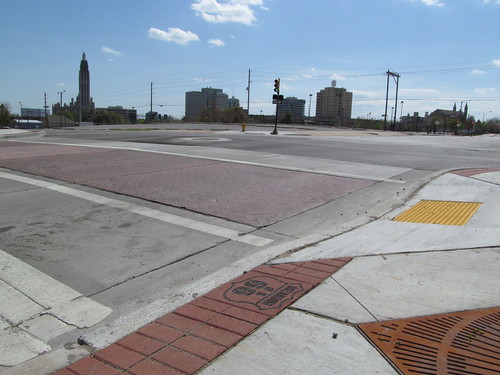
Looking southwest across the parking crater, from 10th and Detroit. Fancy Route 66 streetscaping doesn't make up for the desolation of block after empty block of surface parking.
Along with it should be the removal of financial and regulatory incentives for demolition and obstacles to adaptive reuse. The downtown assessment, which is a flat rate per square foot of building and land, allows a property owner to give himself an instant tax cut with a bulldozer. The owner of the old Page Dairy at 7th and Frankfort did just that in July 2009. Regulations requiring old apartment buildings to retrofit with state-of-the-art fire protection features are another burden on creative building reuse, increasing the likelihood of another demolition of what had been affordable downtown housing.
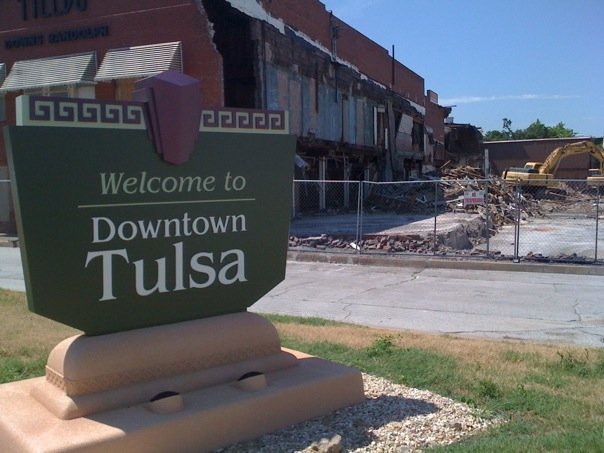
Page Glencliff Dairy (Fields Downs Randolph building) being demolished in 2009. Photo by Daniel Hickman.
Earlier this year, Tulsa won Streetsblog's national competition for worst "parking crater," the vast asphalt wasteland that stretches with few interruptions across the south end of downtown and reaches up along the east fringe. As hoped, the national attention has bolstered the effort to address the problem which began last July with a temporary moratorium.
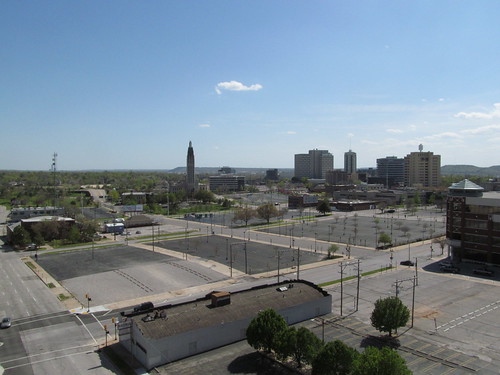
Tulsa Community College, Boston Avenue Methodist Church, and First Methodist Church's contributions to Tulsa's parking crater. Near 10th and Detroit looking south.
And it is a problem. A downtown doesn't work the way a downtown should, it doesn't work as a lively urban district, if there are vast voids between clusters of buildings. Surface parking is an inhospitable environment for someone on foot. When you're walking down a street with parking on both sides, there's no place to go if the weather turns, no one around to help if there's an emergency, nothing to keep you interested.
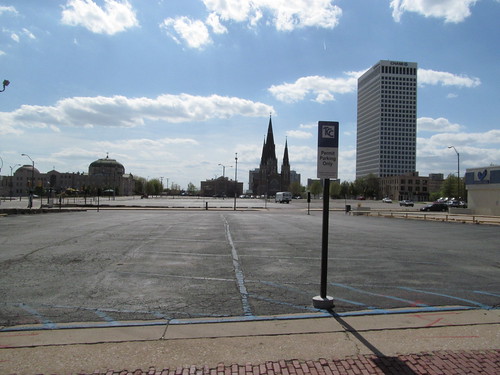
Looking west across the parking crater from Cincinnati between 8th and 9th toward 1st Christian Church and Holy Family Cathedral. Tulsa Community College lot is in the foreground.
I remember a 1996 visit from a college friend. He and a colleague came from Massachusetts to Tulsa that July to man a booth at the American Council of the Blind annual convention. Because they were staying downtown at the Doubletree, they didn't bother to rent a car. What a mistake! The first night in town they set off east on 7th Street in search of dinner, thinking that surely they'd find something downtown. Instead, they found a whole lot of nothing -- empty lots and closed office buildings. The view wouldn't be much different today.
What life we have downtown, we owe to building owners like David Sharp who chose to buy and hold on to modest, usually unremarkable older buildings in the Blue Dome and Bob Wills Districts as one building after another were taken for parking.
Why do old buildings matter? Here's an explanation from my June 7, 2006, column on the legacy of urban journalist Jane Jacobs:
[Jacobs wrote]: "Cities need old buildings so badly it is probably impossible for vigorous streets and districts to grow without them. By old buildings I mean not museum-piece old buildings... but also a good lot of plain, ordinary, low-value old buildings, including some rundown old buildings."Think about the most lively and interesting places in Tulsa, the kind of places you'd take a visitor for a night on the town: Brookside, the Blue Dome District, Brady Village, Cherry Street, 18th and Boston. Each of those districts had an abundance of old buildings, buildings that are for the most part unremarkable. But those buildings provided an inexpensive place for someone with a dream to start a new business.
You might have seen the same kind of vitality develop in the south part of downtown, with business springing up to serve the tens of thousands who attend classes at TCC's Metro Campus or participate in activities at the downtown churches, but so many of the buildings have been taken for parking by the churches and by TCC that a prospective business owner would be hard-pressed to find a location.
"As for really new ideas of any kind - no matter how ultimately profitable or otherwise successful some of them might prove to be - there is no leeway for such chancy trial, error and experimentation in the high-overhead economy of new construction. Old ideas can sometimes use new buildings. New ideas must use old buildings."
Nearly all of downtown is under a special zoning classification (Central Business District, CBD) which, unlike every other part of the city, has no minimum parking requirements for businesses. But the other factors have encouraged demolition for parking: The costs of bringing an old building up to code, demand for office parking during downtown's late '70s, early '80s boom (roughly 70,000 downtown employees), Tulsa Community College's land-banking (buy a building, level it for student parking), reserve it for future development), and Sunday morning demand driven by our unusually healthy downtown churches.
Way back in 1998, the first time I ran for City Council, I proposed a demolition moratorium and a downtown parking summit. Since offices, churches, and TCC all generated parking demand at different times, it seemed like it should be possible to accommodate everyone's needs without dismantling more of what little remains of our urban fabric.
As bad as downtown already was, it was getting worse. Around that time, the Catholic Diocese of Tulsa demolished the Tulsa Apartments at 9th and Main (a pair of four-story brick buildings from the 1920s) and the old Cathey's Furniture showroom along the west side of Main between 8th and 9th. A diocesan spokesman told me at the time that the intention was to build a new chancery building and a grand plaza with the cathedral as backdrop. Instead, they simply tore down the buildings, paved the lot, and striped it for parking, as it remains today.
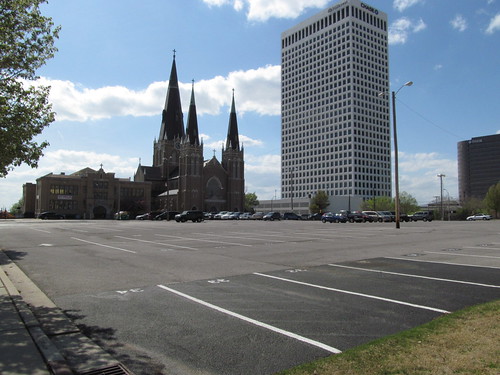
Site of Tulsa Apartments and Cathey's Furniture, 9th and Main, demolished in 1998 by the Catholic Diocese of Tulsa; now surface parking
When downtown leaders began the process of reopening the Main Mall to vehicular traffic, I urged that the city get commitments from adjoining property owners not to demolish their buildings for parking. If the point of reopening the mall was to allow businesses along Main to flourish, tearing down the few remaining buildings would defeat the purpose. Not long after, Arvest Bank demolished three older two-story buildings on the west side of Main north of 6th Street. A few years later, the Tulsa World demolished the old Froug's Department Store on the southwest corner of 3rd and Main for an air conditioning plant, and then Kanbar Properties tore down two single-story retail buildings just north of 5th on the east side of Main.
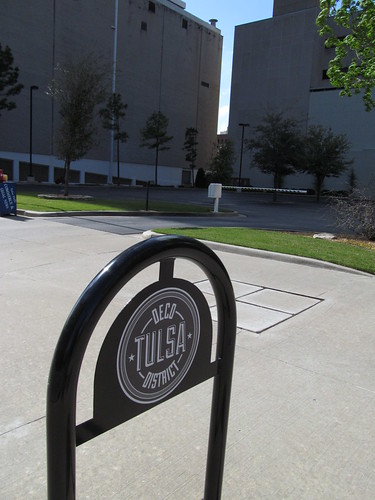
Tulsa Deco District sign decorates Arvest Bank parking lot. The three early 20th century Plains Commercial buildings on this site were pulled down by Arvest in the early 2000s.
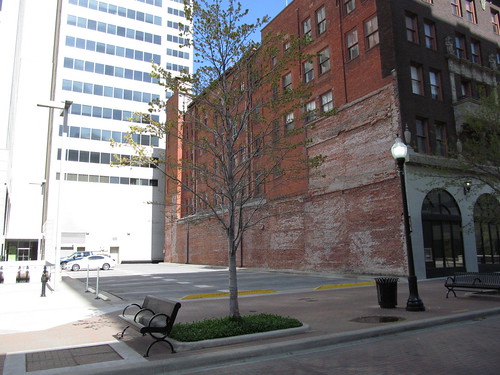
Site of the Lerner Shops building (once the first home to KGCT-TV 41) and another building that were purchased and then demolished by Kanbar Properties.
In 2006, vocal downtown office building owners, who seemed to see downtown as nothing more than an office park, blocked a set of modest downtown preservation measures called the CORE recommendations from even moving out of the recommendation stage. Susan Neal, an advisor to then-Mayor Kathy Taylor on development issues, played a significant role in obstructing progress on the issue, presumably with the knowledge and approval of her boss.
The recommendations were modest and appropriate, but it took five years before they began to become a reality:
- Review all downtown buildings.
- Be proactive in meeting parking demand with structured parking, and discourage surface parking.
- Make downtown preservation a key component of Tulsa's new comprehensive plan.
- Create and promote incentives for redevelopment.
- Create a demolition review panel, to be designated by the Preservation Commission, that could halt demolition of a significant building for up to four months.
Plenty of our peer cities in the region, large and small, have put limits on demolition in the interest of historic preservation. Some have managed to combine historic preservation and parking. In Abilene, Texas, we noticed a number of hundred-year-old one-story buildings that had been opened up for parking. The structure is intact, ready for restoration to a more lucrative use.
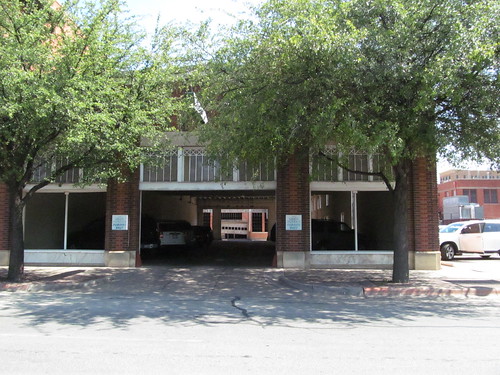
 Old buildings in downtown Abilene, Texas, converted to covered parking, preserving them for some future use.
Old buildings in downtown Abilene, Texas, converted to covered parking, preserving them for some future use.That's been done in Tulsa, too, although it's not as visible. For many years the bottom floor of the old Renberg's building on Main has been used as parking, with access from the alley east of Main. When the Snyder family began to restore the Mayo Hotel, their first step was to convert the basement for parking, generating revenue that was later used to turn the first two floors into a space that could be rented for wedding receptions and other special events.
I urge the TMAPC to allow the proposal to move forward to the City Council. I urge the Tulsa City Council to approve limits on downtown demolition and to provide relief from regulatory and financial burdens that create incentives for demolition rather than reuse.
TAKE ACTION:
You can attend and speak at the TMAPC hearing, which begins at 1:30 pm today in the Tulsa City Council chambers on the 2nd (ground) floor of City Hall. Enter at 2nd and Cincinnati. The item is fairly early in the agenda, after a series of lot splits (usually routinely approved) and some "housekeeping" amendments to the Comprehensive Plan. (Most of those "housekeeping" amendments involve fixing errors in Comprehensive Plan designations, a couple involve patching the plan to reflect zoning decisions made out of accord with the plan, but one would involve commercial intrusion into a neighborhood on the west side of 2nd and Memorial. There's also a proposal to include more legible, large-format maps as part of the printed version of the Comprehensive Plan.)
You can also register your opinions on the City of Tulsa Planning Department's FeedBack site, which has a page devoted to the proposed downtown demolition ordinance. This is treated as official feedback, and you are required, as you would be at a public hearing, to register with your real name and address. (Your address is kept confidential, but you will be identified on the site by name and council district.)
MORE:
Tulsa's progress through the Streetsblog "Parking Madness" competition for America's worst parking crater:
Sweet 16: Tulsa vs. Philadelphia: Tulsa won 95% to 5%. (Philadelphia crater had actually been redeveloped by the time of the contest.)
Elite Eight: Tulsa vs. Cleveland: Tulsa won 77% to 23%.
Final Four: Tulsa vs. Houston: Tulsa won 60% to 40%.
Championship: Tulsa vs. Milwaukee: Tulsa won 82% to 18%.
Streetsblog's report on how Denver repaired its parking crater:
In the 1990s, in response to the creeping cancer of surface parking, the Mile High City took action. The city changed its downtown zoning to eliminate surface parking as a use by right. So if you owned a building, you were welcome to tear it down, but you couldn't park cars on the lot. All existing parking lots were grandfathered in.
A relevant quote from a renowned urban planner:
"Actually, there is a point at which a city can satisfy its parking needs. This situation can be found in many small, older American cities and is almost always the result of the same history: at mid-century, with automobile ownership on the rise, a charming old downtown with a wonderful pedestrian realm finds itself in need of more parking spaces. It tears down a few historic buildings and replaces them with surface parking lots, making the downtown both easier to park in and less pleasant to walk through. As more people drive, it tears down a few more buildings, with the same result. Eventually, what remains of the old downtown becomes unpleasant enough to undermine the desire to visit, and the demand for parking is easily satisfied by the supply. This phenomenon could be called the Pensacola Parking Syndrome, in honor of one of its victims."
-- Andres Duany, Suburban Nation, p. 162 [footnote]
UPDATE:
On September 18, 2013, the TMAPC voted 10-1 to recommend against adoption of the proposed downtown demolition and surface parking ordinance. Bill Leighty was the sole commissioner to support the ordinance. His motion to continue the item for 60 days to allow for further public input and amendment was shut down by an 8-3 vote (Mark Liotta and Dwain Midget voted with Bill Leighty in favor). The TMAPC discussion on the ordinance and all comments filed in favor and against can be found in the backup material provided to the City Council.
On October 17, 2013, the Urban and Economic Development Committee of the Tulsa City Council took up the TMAPC's anti-recommendation. Because the TMAPC took action, the City Council had the power to take up the proposed ordinance and approve it, despite the TMAPC's opposition. No action on this item was recorded in the minutes, but video of the meeting reveals that committee chairman Blake Ewing proposed taking no action on the ordinance whatsoever; councilors G. T. Bynum and Phil Lakin spoke in agreement with Ewing. No vote was taken. There was vague talk of a council task force to try to find consensus and then maybe another attempt in the spring. I can't find any trace of this task force being formed. The proposed ordinance was killed for lack of action by the council committee. Jack Fothergill from the City Attorney's office informed the committee that any councilor could put the item on the council's agenda; evidently none ever did.
Here is video of the October 17, 2013, Tulsa City Council Urban and Economic Development Committee meeting. It uses Windows Media Player codecs, and you will need the Silverlight browser extension to watch it; you might have better luck watching it in Internet Explorer or Microsoft Edge.
And here is video of the September 18, 2013, TMAPC hearing, which runs two hours:
Researcher's note: Sometime in 2017, the city switched to a different provider for online video. The archive of the previous provider (Granicus) is still online, but there is no index for finding the video for a specific meeting. I used a search engine to find video for one 2013 meeting, then tried different values for the clip_id parameter in the URL, going up by 100, finding the right range of dates, then narrowing down to find the exact meeting.
Here is the monthly sales tax news release from Mayor Dewey F. Bartlett Jr's office, dated February 5, 2010. This is two months after Bartlett Jr was sworn in, just shy of three months after he was elected mayor in 2009.
Please especially note the final paragraph, which I've highlighted in bold. It's very interesting in light of recent ads claiming that his predecessor (whom he endorsed for re-election) drove Tulsa to the brink of bankruptcy.
MONTHLY SALES TAX, USE TAX COLLECTIONS
FROM MID-DECEMBER TO MID-JANUARY
The preliminary report from the Oklahoma Tax Commission regarding sales tax collections for the City of Tulsa have now declined 11 consecutive months including the last eight months of declines averaging 11 percent.
According to the preliminary report, sales tax collections from mid-December to mid-January totaled $17,771,635, a 9.8 percent drop from $19,696,317 for the same month last year. Use taxes, which businesses and others pay on purchases of equipment from out-of-state vendors, were above budget estimate at $1,598,877. From the same period a year ago, use taxes have declined by 7.8 percent or $135,619.
"As expected, we are continuing to see sharp declines in our sales tax revenues. Our combined receipts for both sales and use tax are slightly lower than our revised budget expectations,"Mayor Dewey Bartlett said. ''With the $10 million reduction to our general fund, we will continue to monitor expenses closely until the end of the year."
The General Fund portion of sales and use tax totaled $1.34 million for the month, a little less than $100,000 lower than our revised budget expectations.
Mayor Bartlett added, "It should be clear that the economic problems that we are experiencing are the result of declining revenues due to the national recession, not any express actions by the current or previous administrations. Both the Bartlett and Taylor administrations have collectively reduced our annual expenses by $25 million."
Maybe it just took Bartlett Jr another year or so to realize how badly his predecessor (whom he endorsed for re-election) mismanaged the city's finances.
After all, it wasn't until inauguration day that Bartlett Jr figured out that there was a budget crisis at all, even though the woman he endorsed for re-election decided not to run in order to devote her full attention to it, and even though she invited him as Mayor-elect to shadow her at any meetings on her schedule, offered to provide him briefings on critical issues, including the budget crisis, and provided office for him and space for his staff at City Hall during the month-long transition.
Bartlett will be installed as Mayor on Dec. 7. In the meantime, Bartlett and his transition team will begin to deal with the most pressing issues, with the City's budget problems at the top of the list."There is a lot of hard work ahead - this current budget crisis is unprecedented. The finance team and I are ready to get started," said Mayor Taylor. Mayor Taylor plans to brief Bartlett on the current state of this year's budget, and the issues which will need to be considered regarding next year's budget.
"We have an office set up for Mayor-elect Bartlett. He can occupy the office as soon as he would like and we will provide space for other staff as well," said Mayor Taylor.
Each department has drafted a summary of its staff and budget as well as issues to be addressed.
"I will be personally briefing the new mayor, as soon as he is available, on all the issues I am handling that need to be transitioned to the Mayor-elect," Mayor Taylor said.
The Mayor-elect will be invited to attend all management meetings, as well as attend any meeting on Mayor Taylor's schedule. Her staff has prepared a list of events and dates for which the Mayor's presence has been requested after her term ends.
(Both Taylor and Bartlett Jr deserve blame for financial mismanagement, specifically for running up the budget during flush times, forcing painful cuts when revenues shrank. Taylor also refused to deal seriously with concerns raised by then-Councilor Bill Martinson, seeming to treat him as an adversary who needed to be crushed like a bug, rather than an ally in the cause of fiscal sanity.)
The National Trust for Historic Preservation's Preservation Blog has put its spotlight on the efforts of the City of Independence, Kansas, and the Friends of Riverside Park and Zoo (FORPAZ) to preserve the park's historic playground equipment while meeting modern safety requirements:
When Riverside Park's insurance company told park staff that they needed to remove two playground slides dating from the early 1900s for safety reasons, Barbara Beurskens, director of the Independence, Kan. park, knew that she and her team had to find a solution that would keep the metal playscapes in place."These are so important to the community," says park staffer Rachel Lyon of the tall slides manufactured by the now-defunct FUN-FUL company.
The solution involved installing tons of rubber mulch under the slides, improving guardrails, and undergirding ladders to prevent slip-throughs.
So often the difference between demolition and preservation is affection. City officials confronted with an insurance company's warning often respond with a helpless shrug, followed by an order to send the bulldozers. That's easier to do if you have no emotional connection to what's about to be torn down.
But the city officials here understood that generations of former children from Independence and the region have rich memories tied to these slides and see-saws, memories of overcoming their fears, memories of games of imagination.
I note from a websearch that Park Director Beurskens has worked for the City of Independence in one capacity or another for over 30 years -- clearly, she's been around long enough to understand that "This Place Matters" (to borrow an NTHP slogan). Perhaps she had children of her own who grew up playing on the big slides.
NTHP's Katherine Flynn has included (with my permission) some of my photos of Riverside Park's historic playground equipment from 2007. After an earlier visit in 2003, I described the equipment and wrote about my amazement that the playground equipment I remembered from my childhood visits was still there and in use, and I alluded to the liability concerns that have caused classic equipment to vanish from playgrounds and parks across the country.
A spinning circle -- the kind with the raised elongated bumps at right angles for traction, and bars radiating and rising from the center, then forking out and connecting to the edge. [My son] Joe was riding it, having me spin him faster and faster. As he was spinning, and as I was pondering whether, out of appreciation for the City of Independence having the guts to keep this classic play equipment available, I would refrain from filing suit if one of my kids were injured -- as if he could read my mind, Joe launched himself off the circle. His foot was caught by one of the handholds and it seemed he might be dragged around, but the circle stopped quickly. Joe was fine, grinning. He got up, brushed off the sand (that's what they use around all the play equipment -- not hard, splintery wood chips, but nice soft sand). "I intended to do that. I thought it would be cool to jump off!"
We passed through Independence in May, and we spent a couple of hours there walking through part of the zoo, riding the train and the carousel, and playing on the playground. It was a gray and damp day, so the slides didn't move very fast. Here are a few pictures which show some of the safety improvements:
MORE:
Visiting Riverside Park: The park is open 6 a.m. to midnight daily. The train, carousel, and mini-golf are open weekends from 1 p.m. to 8:30 p.m. and weekdays from 5:30 p.m. to 8:30 p.m. between Memorial Day and Labor Day, and weekends from 1:30 to 5:30 p.m. in spring and early fall. (October 20 is the last day in 2013 for the rides and mini-golf.) The zoo is open 9 a.m. to 7 p.m., April through October, then 9 a.m. to 5 p.m., November through March.
City of Independence Riverside Park and Ralph Mitchell Zoo webpage
Riverside Park and Ralph Mitchell Zoo on Facebook
Friends of Riverside Park and Zoo (FORPAZ) website
Friends of Riverside Park and Zoo (FORPAZ) on Facebook
BONUS: Playground swings sound like trumpeting elephants:
Twelve years ago today, America was attacked by Islamofascist fanatics. Thousands of innocent people lost their lives, tens of thousands were injured, hundreds of thousands were left orphaned or widowed or deprived of a dear friend.
We particularly remember today a graduate of Tulsa's Memorial High School, Jayesh Shah, who was in at his office in the World Trade Center's North Tower when the first plane hit. Jay was a devoted husband, father, brother, and friend. Here is one tribute page to Jayesh Shah, with memories and expressions of love from his children, relatives, and childhood friends.
In 2006, on the fifth anniversary of the attacks, Jay's family presented a memorial flag, inscribed with the names of the 9/11 victims, to Katy, Texas, Elementary School, where his children had been students. The story of the presentation provides this capsule summary of his life:
He played Little League football and baseball, high school soccer and, in 1980, became Oklahoma state chess champion. He received a bachelor's degree in petroleum engineering from the University of Tulsa, then went on to get a master's degree in computer science and begin work with Amoco in Chicago, then Houston.Through it all, he retained a reputation for being easygoing and carefree, a man on the fast track professionally who greeted life with gusto and an almost perpetual smile.
He had moved his family to Edgewater, N.J., easy commuting distance to New York City, where he worked as vice president of eSpeed, a division of investment traders Cantor Fitzgerald, when he became one of the company's 658 employees who died on 9/11.
Jay was highly esteemed by his extended family, too, as evidenced by this from the Hindustan Times story about the 10th anniversary commemoration of the attack:
The Galas of Connecticut have made it to all the anniversaries of the attack. They come to Ground Zero every year, just to connect with Jayesh Shah, a relative who had worked for Cantor Fitzgerald...."He had a great smile and was like the big brother to my children," said Mansukh Gala, of Indian descent. Jayesh was his wife Manju's nephew. The entire family was at Ground Zero, wearing T-Shirts bearing images of Jayesh. On the back, shirt simply said: 10 years, we will never forget.
If you find yourself forgetting, I'd encourage you to watch the eyewitness videos that the History Channel has collected: 102 Minutes That Changed America: The second plane hitting the south tower, as seen from near Trinity Church, the people sprinting down Maiden Lane ahead of a wall of dust, the panic as the South Tower collapses and people begin to run for their lives.
The movement that attacked America on 9/11 is still in existence, notwithstanding the elimination of many of its leaders. This movement is fueled by a hate-filled ideology that America's leaders hesitate to name, much less oppose. It is on the march across the Middle East, replacing secular kleptocrats with Islamic totalitarians, and it reaches through cyberspace to warp the minds of young men living in the west, to inspire acts of "sudden jihad syndrome," in which a Muslim appoints himself an instrument of Allah's vengeance against the corrupt West and its interventions in the Middle East. The attacks at Fort Hood and on Boston Marathon spectators are two prominent examples. In September 2008, the quick reaction of an Oklahoma Highway Patrolman narrowly averted a similar massacre at the 41st and Sheridan Burger King in Tulsa.
What's at the heart of Islamofascist terrorism? Ace sees a pattern:
Meanwhile, Ron Paul, who's Raising Some questions of his own tonight at an organization which Questions the Math on the Holocaust (or... Holoclaim), says 9/11 was nothing but blowback for our imperial adventurism.Um, no, that's the pretext. Islamofascist psychopathy is fundamentally psychological in nature. It is an ideology of the deranged which uses a Hero Fantasy to give succor and meaning to a Soul in Shame. It's not quite true that they hate our freedoms primarily-- they hate those, but not primarily. They hate, in ascending order, our Wealth, our Success, and our Might.
The weak man always secretly hates the strong man, and the deranged weak man sets about doing something about it. And I don't mean "useful steps towards self-improvement."
Crediting Al Qaeda's stated reasons for attacking us is like crediting the stated reasons of a Stalker who shows up at your door with a knife and says "You shouldn't have gone to my supermarket." Yes, that's the stated reason, the pretext, but the real reason is an unreasoning hate and an obsessive thirst for vengeance for slights both real and mostly imagined.
Imagine if the police told you at this point: "He's quite right, you know. You shouldn't have gone to his supermarket. What were you thinking, provoking him like that?"
You'd call that cop an idiot, wouldn't you?...
Anyone still citing the Shame of Vienna as a justification for murder isn't an example of blowback. It's an example of lunacy. And yes, we need to diagnose lunatics... but we don't permit them to self-diagnose and then take their diagnosis as accurate.
Here's another thought about the source of that shame: Having failed at internal jihad -- what my reasonable Muslim friends call the true holy war against one's own evil impulses -- they have turned to external jihad to solve their own sin and shame problem. The West, the source of the temptations that they cannot resist, must be forced to submit to Islam so that the temptations will go away.
Jesus had an answer for that: "What comes out of a man defiles a man."
Shortly after 9/11, Ann Coulter famously wrote: "We should invade their countries, kill their leaders and convert them to Christianity." There was great outrage, but she was right. The only hope for this shame-filled, angry, young men is the message that God Himself humbled Himself, bore their sin and shame, and offers them redemption and eternal life and adoption as His own beloved children. The same is true for all the deranged young men who have blown up buildings and shot up schools and movie theaters and shopping centers. They need the liberating hope of the Gospel of Jesus Christ. Shame on our leaders, Republican and Democrat alike, for being so overly sensitive to Islamism that they have hindered the spread of the Gospel to the lands that our nation -- military forces filled with followers of Christ -- helped to liberate.
(NOTE: No, I don't mean convert them to Christianity at the point of the sword, and I don't think Coulter did either. But we could at least have required the new governments in Iraq and Afghanistan to enshrine freedom of religion in their constitutions and to allow mission organizations the freedom not only to help rebuild the country but to preach the Gospel openly.)
Not only have we failed to stop this movement, our own government seems determined to aid it. From Erick Stakelbeck's column today commemorating the 2001 and 2012 attacks:
Today, on September 11, 2013, one year after the Benghazi attack and just twelve years removed from 9/11, the U.S. government is throwing its weight behind forces--whether Al-Qaeda types in Syria or Muslim Brotherhooders in Egypt and elsewhere--that share the exact same totalitarian, anti-American ideology as the jihadists who brought down the Twin Towers.Which begs the question: what exactly do we have to show for twelve years of American blood and treasure expended in the War on Terror?
President Obama's willfully misleading claims during the 2012 campaign season that Al Qaeda was "on the run" and "nearing defeat" notwithstanding, AQ and its allies and affiliates now cover more geographical ground than they did on 9/11: from Pakistan and Iraq to Syria, Yemen, Somalia, Libya, North Africa, Sinai, Nigeria, Algeria, Europe and beyond.
Likewise, Al Qaeda's ideology has inspired a generation of young followers in the West, resulting in the kind of terror and mayhem we saw unleashed by the Tsarnaev brothers in Boston last April.
Our government won't even go after those responsible for the Benghazi attack:
Despite President Obama's pledge to "hunt down" the Islamic jihadists who slaughtered those four brave Americans in cold blood, to date, not one suspect has been killed or apprehended.This despite the fact that one of the main suspects in the attack, Ahmed Khattala, has granted lengthy interviews to the New York Times, CNN and several other American news outlets and saunters around the streets of Libya in plain sight even today, almost daring the Obama administration to come get him.
At least one congressman believes that there may be a cover-up behind the lack of presidential drive to pursue the culprits of the Benghazi attacks. Frank Wolf of Virginia is asking whether some of the weapons the US is helping to "stockpile and secure" in Libya, at a cost of $400 million according to a State Department spokesperson, have wound up in the hands of Syrian rebels:
"I firmly believe that whatever the State Department and CIA were doing in Benghazi had a direct connection to U.S. policy in Syria--a policy that to date has not been fully revealed to the American people or Congress," Rep. Frank Wolf (R., Va.) said on Monday evening during a discussion focusing on "unanswered questions" surrounding the Sept. 11, 2012, attack that killed four Americans."Were these rebels being armed with weapons collected in Benghazi?" Wolf asked, according to a copy of his prepared remarks. "Again, there is reason to believe this may be the case and a clear explanation is warranted."
We must continue to target terrorist networks, eliminate their leaders, and frustrate their efforts at coordination. A lone fanatic can do great damage, but not as much as a coordinated, planned attack.
But we must also attack, with weapons of love and truth, the despair and rage that fuel sudden jihad syndrome and Al Qaeda recruitment. Pray for Christians who are taking the Gospel to Islamic countries and to Muslims in the United States. Learn how to share the Gospel with your Muslim neighbors. Contribute funds to mission agencies reaching out to the Muslim world. Send encouragement to persecuted Christians in Muslim countries.
Deborah Brown Community School, a elementary school in downtown Tulsa chartered under the aegis of Langston University (a historically black state university), has come under attack as a result of a misleading Fox 23 report about a parent's decision to remove his daughter from the school because the school prohibited his daughter's preferred hairstyle.
The Fox 23 story and descriptions linking the story on their Facebook page state that the girl was sent home because of hairstyle and that the girl was told directly by school officials that her hairstyle was unacceptable. The Fox 23 story had the girl on camera, sobbing, "They don't like my dreads." Facebook commenters reacted with outrage: How dare they make a little girl cry! How dare these racist school officials ban a natural, culturally significant hairstyle!
What actually happened is that the school reminded the girl's parent that the hairstyle was expressly against the school rules, and the parent chose to move the girl to a different school. This is according to a statement from the school sent in response to a question from the Huffington Post.
So the school did NOT kick the student out, did NOT send the student home, did NOT confront the little girl about her hair.
The point of a school uniform and dress code is that an elementary school is not a place to make a fashion statement or express your personal style. Elementary school is a place to be taught the basics -- reading, writing, arithmetic, geography, history (names and dates) -- the grammar of learning, the foundation for further education in every subject. The overarching theme of the school's policy on hair is that hairstyles should be plain and simple.
Here is the Deborah Brown Community School parent/student handbook. And here is the entire section on the dress code:
Our philosophy and program aspires to raise the level of academic excellence through respect for learning. The students, therefore, dress in a uniform to encourage respect and seriousness of school. Students attending DBCS are required to wear black or brown shoes and the appropriate uniform as designated by the Executive Director. BLACK OR BROWN TENNIS SHOES ARE NOT ACCEPTABLE. It is suggested that each child have a minimum of four complete sets of uniforms. Any student not wearing the proper uniform Monday through Friday will be sent home for non-compliance to the school dress code. Hairstyles such as dreadlocks, afros and other faddish styles are unacceptable. For safety reasons, girls weaved hair should be no longer than shoulder length. Boy's hair is to be short and neatly trimmed. Boys are not allowed to wear earrings.If it is necessary to wear non-uniform clothing not only for emergency reasons, but Free Dress Day, students will not be allowed to wear letters, numbers or pictures on their garments. This rule applies to all students. Student dress should be conservative and modest. Free Dress Day will always be announced in writing.
Some online commenters declared that the school must be racist, because they are discriminating against "natural" ethnic hairstyles like dreadlocks and afros. When I pointed out to someone on Twitter that the founder/director of the school, the entire board and administration, and most of the faculty are African-American, the response was, "Phyllis Schlafly is female. Self-loathing is a terrible thing. Worse when it's projected onto members of one's own demographic."
Anyone who knows Phyllis Schlafly knows that there isn't an ounce of self-loathing in her.
She disagrees with leftists about what policies are in the best interests of American women, and she believes that women (and men) are best served by traditional family structures and values. It's a typical and ridiculous leftist tactic to strip an opponent of her worth and humanity and to discount her views by labeling her as self-loathing.
By the way, there's nothing natural about dreadlocks, afros, or mohawks for any hair type or ethnicity. Dreadlocks -- consisting of deliberately matted hair -- require a great deal of work to create and maintain, as do bushy afros and mohawks. Dreadlocks have cultural meaning to Rastafarians, who reject cutting and combing hair, but not to those of African descent generally. I was amused to find this September 1970 Los Angeles Times wire service story about fashionable Tanzanian women adopting the Afro fad in imitation of Americans, to the dismay of local nationalist leaders who considered it an example of Western cultural imperialism.
So here we have a group of African-Americans, led by a woman, who had a vision of doing a better job than the public schools at educating African-American children. A part of that vision is structure and discipline, an emphasis reflected in the school's dress code.
By all accounts, the Deborah Brown Community School is succeeding: DBCS received a "B" grade for 2011-2012. Of the Tulsa Public School district's 53 elementary schools, only 8 did as well or better.
The point of a charter school is to encourage innovation in education and to provide parents with tuition-free options so they can find the best educational approach for their children.
From a Tulsa World story on the Deborah Brown Community School and its plans to expand to include middle school grades:
The Deborah Brown school is sponsored by Langston University. About 250 students are enrolled, and 110 are on a waiting list.By virtue of its location, 95 percent of its students are black, Mikel said. ...
The Deborah Brown school has high academic and behavioral expectations for its students.
As students walk down the hallways to wash their hands before lunch, they are quiet and well-mannered. Teachers place graded papers along the hallway for all to see. Most received A's.
The school uses an instructional method developed by its founder and namesake, and the curriculum is focused on reading, writing and math.
It also has a mandatory uniform policy and strict discipline policy and requires a strong commitment from parents to help their children reach their potential.
Mikel said that when he first came to the school, he heard children reciting something but wasn't sure what it was. It turns out, students were reciting the chemical elements from memory.
"I thought they were speaking a foreign language," he said with a laugh.
Shame on Fox 23 for damaging the reputation of a successful school serving African-American children by presenting this story in such a slanted and emotionally manipulative fashion.
MORE: Here's a more specific reference to the Tanzanian writer who dissed the American-style afro, from the February 1973 issue of Ebony, in an article entitled, "Is the Afro on Its Way Out?"
Surprisingly, one of the most vitriolic denouncements has come from an East African writer, Kadji Konde, who sees little resemblance between the big bush and the short styles worn by many African women. Rejecting it as a symbol of imperialist American decadence as purveyed by Westernized blacks, Konde wrote in a Tanzanian newspaper: "How natural these nests are is a mystery to me. In the United States, where this hairdo comes from, it is called an Afro style. This implies a link with Africa, although I fail to see how this keeping of wild oiled bush on the skull has anything to do with dear mother Africa." The attack as published was accompanied by a picture of Angela Davis.Other common complaints are limitations on the types of hairstyles one might attempt with a 'fro, the difficulty of wearing a hat over a very large one in winter which means a whole recombing process each time the hat is removed and the gripes of both 'fro and non-'fro wearers who have found themselves seated in theaters or concert halls behind those whose towering bushes obscured any view of the stage.
And a story in the October 25, 1971, edition of Time, began:
From the time that it first appeared on the scene five years ago, the "natural" or Afro hair style closely paralleled the growth of black pride. Becoming a political statement and a symbol of racial identity as much as a popular hair style, it gradually billowed from close-cropped cuts into dramatic, spherical clouds that framed the heads of both women and men. Now that blacks feel more secure about their identity and are achieving some of their political goals, the popularity of the Afro has begun to wane.
If you're asking if a recently popular hairstyle is "on its way out" -- that's pretty much the definition of "faddish," isn't it?
STILL MORE:
Here is a playlist of videos about DBCS: A promotional video aimed at potential donors, a couple of news stories, and a couple of home videos. I don't get the impression that these students are being steeped in self-loathing.
